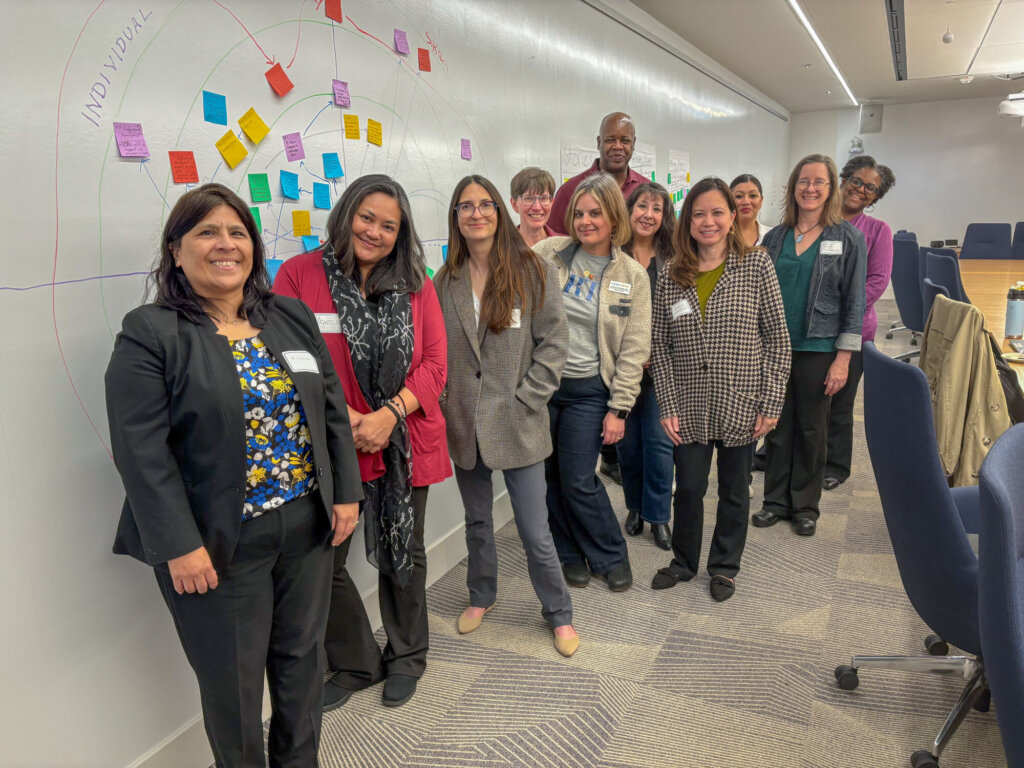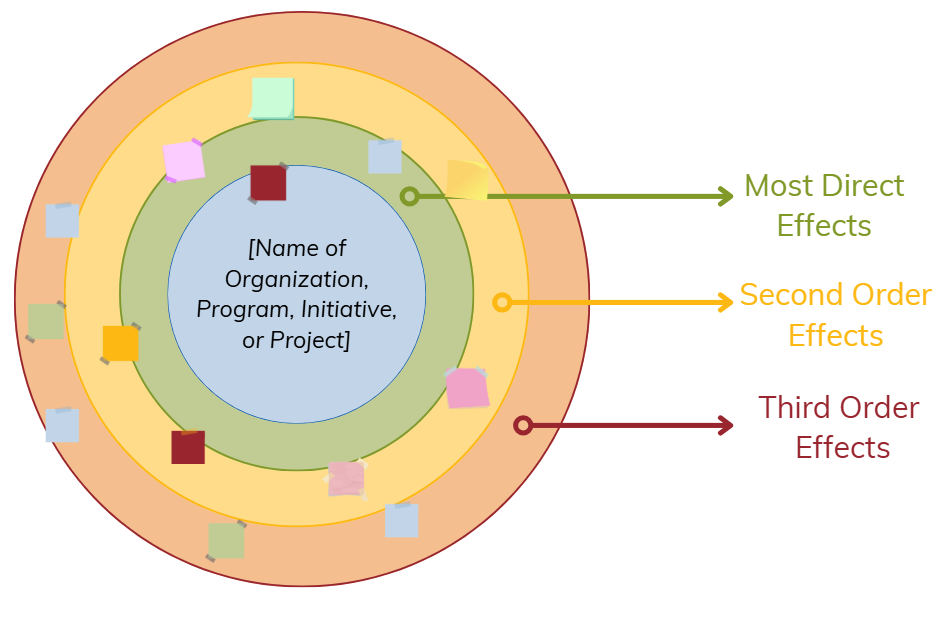Overview
Ripple Effect Mapping session participants as part of our work with the California State University Student Success Network.
Broadly speaking, ripple effect mapping (REM) engages people in reflecting upon and visually documenting the significant intended outcomes and unanticipated impacts of a given program, project, or initiative’s interventions with which they have interacted. Facilitators guide participants to create visual maps that show the pathways of events or activities that led to the changes, as well as any follow-on or related effects connected to them.
REM can give insights into individual and community-level changes and employs elements of Appreciative Inquiry*, outcome and mind mapping, participatory analysis, and qualitative data analysis.
As part of our commitment to participatory evaluation, we have evolved the REM method as described originally in A Field Guide to Ripple Effects Mapping. We often seek, develop, and adapt research methods to make them more participatory, offer benefits to participants, and those gleaned by the commissioners of evaluation.
(* Appreciative Inquiry is a way of thinking about the world around us. It invites us to think and ask questions about the positive things we appreciate and value. It asks, “What do we want more of in our lives?” Appreciative Inquiry is a hopeful mindset in which change comes with curiosity, wonder, and encouragement for a better future.)
How It Works
REM sessions consist of four primary components.
We design our REM sessions to collect data that answers an evaluation project’s learning objectives and evaluation questions. As part of our commitment to participatory evaluation, we have evolved the REM method as described originally in A Field Guide to Ripple Effects Mapping. We often seek, develop, and adapt research methods to make them more participatory, offer benefits to participants, and those gleaned by the commissioners of evaluation.
In our experience, 12-15 participants per session is ideal, with an expected engagement time of 3-4 hours (including time for introductions, breaks, lunch, etc.). Depending on the scope of the intervention, we host multiple REM sessions per engagement (e.g., multiple chapters or locations of a parent organization). We work with our clients to identify attendees that we believe will provide the most diverse, enriching, and candid insights.
REM sessions follow a four-part format, with participants working in different group sizes and configurations at different points during the session. Sessions are ideally completed in person, though virtual sessions are also possible.
The Components
1. Paired Appreciative Inquiry Interviews
Using Appreciative Inquiry, each participant shares a story of a significant change or accomplishment that occurred because of the intervention being examined. The listener will make brief notes about the story as they hear it. All REM sessions begin with a similar prompt: "Please tell one another a story or example about a time when you felt especially proud of, energized, excited, or enlivened by, a change in the world (e.g., to individuals, groups, organizations, policies) to which [intervention] contributed in some way. Be as specific as possible and consider: Who or what changed? How or in what ways? What led to the change? What became possible or resulted (at least in part) because of the change?"
2. Affinity Mapping & Clustering
The group works to identify thematic commonalities and differences in the “stories of change” they shared in the paired interviews, clustering “like with like” and describing the categories they observe, including elements of the intervention that created the change reported in the story. Participants work with the facilitator to examine the clusters and adjust or organize them so they can discuss what has emerged. From these themes, facilitators draw analytical categories to subdivide the “ripples” in the map for the next step.
3. Ripple Effect Mapping
In the “main event,” participants map the stories of change onto a Ripple Effect diagram that takes the form of a three-ringed target. Stories are broken down into “steps” with each step being positioned somewhere on the map. A change originating in one ripple and slice of the map might lead to changes in other places. After determining the most direct, second-, and third-order effects, the group may further segment the map (e.g., institution types, geographic regions, user categories). Participants are prompted to draw lines between steps they see as connected and label them with the relationship (e.g., “leads to” or “comes before”), identifying as many connections as possible.
4. Reflections & Takeaways
After creating the ripple effect map, participants often reflect on it together, identifying what they find significant or interesting and whether anything has been excluded. This process often yields new insights into the intervention’s accomplishments, gaps, and crosscutting themes.
REM Benefits
For the Client
- Elevating perspectives: Participatory approach that engages stakeholders at a high level and amplifies their voices.
- Enriched findings: Emerging themes that can be validated and confirmed in real-time by those most deeply in and/or affected by the work. These themes can be overlooked when participant insights are collected individually and without space for them to exchange thoughts.
- A picture tells a thousand words (or so): Visually capturing the impact of otherwise complex or intertwined interventions to understand.
For the Participant
- Feeling of solidarity and accomplishment: Across the REM sessions Informing Change has held, we’ve consistently heard that participants felt connected to others and had a sense of pride/accomplishment when seeing the ripple effects of their work or the program they were involved with.
- A chance to connect and re-energize: A REM session brings together people who have the same, similar, or related roles, but rarely get a chance to interact regularly. This gives participants an opportunity to make new or sustain existing ties with one another and potentially increase the likelihood of mutually re-energizing and revitalizing each other in the work.
- An intentional space to pause, reflect, and grow in the work: We have repeatedly seen that the very act of pausing, asking questions, and bringing people together in a research-oriented conversation enhances or strengthens the intervention about which we’re inquiring.
- Research participation incentives: In alignment with our priority on acknowledging the value and efforts of participants in data collection, we strive to acknowledge the participants’ time and the opportunity cost they have taken on in agreeing to participate. This can include providing a financial incentive (e.g., direct compensation or charitable donation), reimbursing travel or childcare costs, and providing a meal.
“I came so I can protect my peace, be in stealth, and still get what I need … So today was rejuvenating and I can hold onto this little piece of light until I get another piece of light.”
“Hearing the stories and seeing the ripple effects gives me hope … Sometimes when we have limited resources or you see the culture changing, you get mired down … Sometimes we need to hear the hope and the positive stories.”
“Highlighting the beauty and importance of the Network to provide a platform for us to have those common experiences. There’s a lot of value in that for a system as large as ours. It keeps us connected and strengthened.”
– REM Participants, CSU Student Success Network
Additional Resources
For further reading:
- See our case study of our work with the Stanley Center for Peace and Security, which incorporated Ripple Effect Mapping (the final product is pictured above).
- Kollock, D. H., Flage, L., Chazdon, S., Paine, N., & Higgins, L. (2012). Ripple Effect Mapping: A “Radiant” Way to Capture Program Impacts. The Journal of Extension, 50(5), Article 33. https://doi.org/10.34068/joe.50.05.33
- Chazdon, S. Emery, M. Hansen, D. Higgins, L; Sero, R. (2017). A Field Guide to Ripple Effects Mapping. Retrieved from the University Digital Conservancy, https://hdl.handle.net/11299/190639.
- A primer on the Appreciative Inquiry process from The Center for Appreciative Inquiry.



